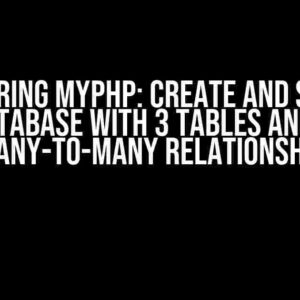When it comes to building robust and secure APIs with Go and Gin, understanding how maxLength and minLength are translated is crucial. In this article, we’ll delve into the inner workings of these essential validation parameters and provide you with a step-by-step guide on how to implement them in your Go-Gin projects.
What are maxLength and minLength?
maxLength and minLength are two fundamental validation parameters used in Go-Gin to restrict the length of input strings. These parameters are essential in preventing common web application vulnerabilities such as SQL injection and cross-site scripting (XSS).
maxLength specifies the maximum allowed length of a string, while minLength specifies the minimum required length. By setting these parameters, you can ensure that user input conforms to specific constraints, reducing the risk of security breaches and data corruption.
How are maxLength and minLength translated in Go-Gin?
In Go-Gin, maxLength and minLength are translated into validation rules using the `binding` package. This package provides a set of functions for validating and binding request data to structs.
To illustrate how maxLength and minLength are translated, let’s create a simple example. Suppose we have a `User` struct with a `name` field that has a maximum length of 20 characters and a minimum length of 3 characters:
type User struct {
Name string `json:"name" binding:"required,min=3,max=20"`
}In this example, the `binding` tag specifies that the `name` field is required and must have a minimum length of 3 characters and a maximum length of 20 characters. When a request is received, Go-Gin will automatically validate the input data against these rules.
Validation Rules in Go-Gin
Go-Gin provides a range of validation rules that can be used in conjunction with maxLength and minLength. These rules include:
- required: specifies that a field is required
- min: specifies the minimum value of a numeric field
- max: specifies the maximum value of a numeric field
- email: specifies that a field must be a valid email address
- len: specifies the exact length of a string
- gt: specifies that a numeric field must be greater than a specified value
- lt: specifies that a numeric field must be less than a specified value
These validation rules can be combined to create complex validation logic. For example:
type User struct {
Age int `json:"age" binding:"required,gt=18,lt=100"`
Email string `json:"email" binding:"required,email"`
}In this example, the `age` field must be a required integer greater than 18 and less than 100, while the `email` field must be a required valid email address.
Custom Validation Rules in Go-Gin
In addition to the built-in validation rules, Go-Gin also provides a mechanism for creating custom validation rules. This can be achieved by implementing the `binding.Validator` interface.
For example, suppose we want to create a custom validation rule that checks if a string contains a specific keyword:
type keywordValidator struct{}
func (kv *keywordValidator) Validate(v interface{}) error {
value, ok := v.(string)
if !ok {
return errors.New("expected string value")
}
if strings.Contains(value, "keyword") {
return nil
}
return errors.New("string must contain the keyword")
}We can then register the custom validation rule with the `binding` package:
func init() {
binding.Validator.RegisterValidation("keyword", &keywordValidator{})
}We can then use the custom validation rule in our structs:
type User struct {
Bio string `json:"bio" binding:"required,keyword"`
}Best Practices for Using maxLength and minLength in Go-Gin
To get the most out of maxLength and minLength in Go-Gin, follow these best practices:
- Use maxLength and minLength consistently throughout your API to ensure consistent validation logic.
- Set maxLength and minLength values based on business requirements and data constraints.
- Use custom validation rules to implement complex validation logic.
- Test your API thoroughly to ensure that validation rules are working as expected.
- Use error handling mechanisms to handle validation errors and provide informative error messages to users.
Conclusion
In conclusion, maxLength and minLength are essential validation parameters in Go-Gin that help prevent common web application vulnerabilities. By understanding how these parameters are translated into validation rules and following best practices, you can build robust and secure APIs that protect your users’ data.
Remember, validation is an ongoing process that requires continuous testing and refinement. By staying vigilant and adapting to changing requirements, you can ensure that your API remains secure and reliable over time.
| Parameter | Description |
|---|---|
| maxLength | Specifies the maximum allowed length of a string |
| minLength | Specifies the minimum required length of a string |
We hope this comprehensive guide has provided you with a deep understanding of how maxLength and minLength are translated in Go-Gin. If you have any questions or need further clarification, please don’t hesitate to ask.
Frequently Asked Question
Get the scoop on how go-gin translates maxLength and minLength!
What is the role of maxLength in go-gin validation?
maxLength specifies the maximum number of characters allowed in a field. In go-gin, it’s used to validate the length of a string and ensure it doesn’t exceed the specified limit. This is super useful for preventing overly long input that could cause issues in your application!
How does minLength work in go-gin?
minLength is the counterpart of maxLength! It sets the minimum number of characters required in a field. In go-gin, it ensures that the input string meets the specified length threshold, preventing too-short inputs that might not be valid or useful.
Can I use both maxLength and minLength in go-gin validation?
Absolutely! You can use both maxLength and minLength together to define a range of acceptable lengths for a field. This is particularly useful when you need to ensure input strings fall within a specific range, such as a username that must be between 3 and 20 characters long.
What happens if I don’t specify maxLength or minLength in go-gin?
If you don’t specify maxLength or minLength, go-gin won’t enforce any length constraints on the field. This means the input string can be any length, which might lead to validation issues or errors in your application. So, it’s essential to define these constraints to ensure data quality and consistency!
Can I customize the error message for maxLength and minLength validation in go-gin?
Yes, you can! In go-gin, you can customize the error messages for maxLength and minLength validation using the `ErrorMessage` field. This allows you to provide a more user-friendly and informative error message that guides the user to correct their input.



